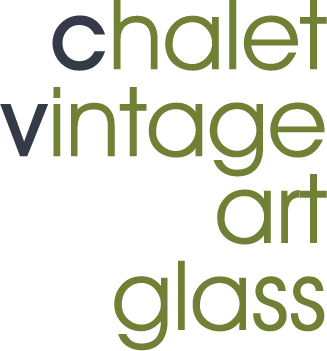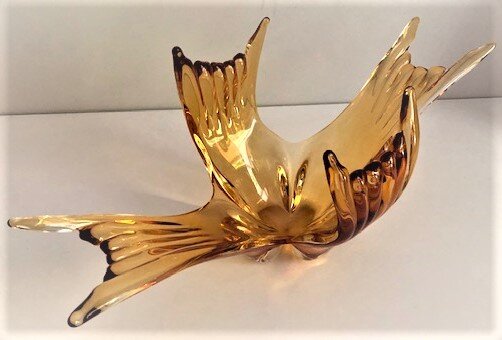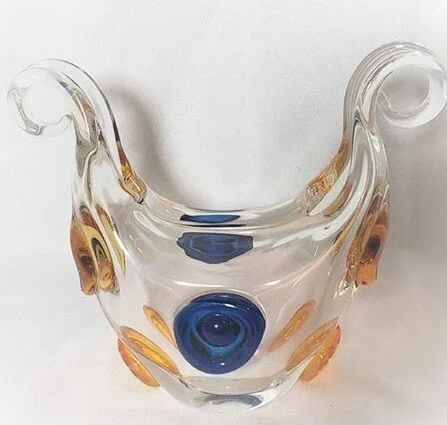Chalet glass blowing design techniques
Before looking at some Chalet specifics, I need to make a general statement about the commonality of shared design elements between the Italian/Canadian glasshouses (EDAG, Chalet Artistic Glass, Mosaic Artistic Glass and Lorraine Glass Industries) of the Chalet era. This makes identifying unmarked pieces very difficult. Design features like pulls, grooves, twists, claws, feathers that you most often associate with one glasshouse can be misleading as many cross over between the glass houses.
Design was fluid and we have learned to say, “Never say Never.” This stretch centerpiece is signed with the ‘Chalet Canada’ etching. A perfect example of shared and, sometimes leading to confusion, design commonality.
So, that being said, let’s examine some Chalet design and glass blowing particulars:
avventurina: gold or silver dust or flecks were added to the clear glass producing a shimmering effect. These may appear on the surface or submerged within layers of clear crystal. Both gold and silver are seen in some Chalet animals – namely some elephant, polar bear, bird, rabbit, owl, cat and fish figurines. This is found in both Chalet’s clear crystal and coloured figurines. These are not to be confused with the more typical anima figurines from Chalet’s “Canadiana Wildlife line.” To date, we have seen no larger avventurina Chalet pieces nor any avventurina in any size or style by Lorraine, Mosaic and EDAG.
Avventurina in clear crystal is not commonly seen.
Nor is silver in an elephant – gold is typically seen in these with silver typically seen in the polar bears.
A most unusual avventurina Chalet polar bear – both in the silver placement and in the olive colouring of the figurine. Blue is the standard for Chalet avventurina figurines, so this is very rare.
bullicante: air bubbles are blown or injected into the glass to create a design pattern “controlled” by the artist. This is a deliberate placement of bubbles as compared to the random bubbles created using the pulegoso (uncontrolled bubble) technique – see below. We have found a handful of larger Chalet pieces that are bullicante – a flat paperweight, a vase, ashtrays and a bowl. All have been in gold or amber However, the most commonly seen bullicante Chalet are the unique animal figurines. Bullicante was sometimes combined with the avventurina technique in these figurines as well. It is common to find EDAG, and Lorraine pieces that are bullicante. To date, we have found no verified Mosaic pieces with bullicante.
An avventurina and bullicante cat and owl figurines. Photograph courtesy of the Zhao family.
cased: glass with two thin superimposed layers. The inside layer may be opaque white to let the outer layer remain opaque. Usually then encased in clear glass. Not a technique we see in pieces by Chalet or Mosaic but used by Lorraine and EDAG. I have included a Lorraine piece here as it is an excellent illustration of this technique.
Photograph of this Lorraine Glass Industries piece courtesy of Brad McGillivray.
forato: a “pierced” piece – one with a hole as part of its design. Rarely used by Chalet but commonly used by EDAG. To date, we have no verified examples of Lorraine or Mosaic pieces with this feature.
Perfect example of commonly shared design elements and techniques which can make identifying a maker so difficult. So – which is what? The amber ashtray is early production Chalet, #A40 in their “Items Available” brochure, while the blue ashtray is EDAG. The Chalet piece from the collection of Pierre Denis.
inclusions: a foreign object intentionally placed in the glass to add to the beauty of the piece. To date, this technique has only seen in Chalet forms and only in their paperweights. To date, we have not found any pieces by Lorraine, EDAG or Mosaic with inclusions.
The adding of inclusions meant that the piece was both molded and hand worked. Paolo De Marchi, son of Chalet artist Roberto De Marchi, has recommended this series of excellent videos which demonstrate not only how an inclusion was encased but how different paperweights are created.
Iris inclusions. Chalet also made paperweights with blue iris inclusions.
This paperweight with its blur of ‘confetti’ inclusions was created by taking crushed glass in various colours and warming this up, in a specialized smaller oven, to the melting point. Then liquid crystal would be put into a mold and the coloured glass would be encased by that. It would then be hand finished and shaped into the egg. I urge you to view the linked video 9above) as it makes this process so clear.
murrine: singular murrina. Refers to a type of mosaic glass with colored patterns or images. Murrine can be made in infinite designs from simple circular or square patterns, from abstract geometrics to complex detailed designs and to even portraits of people. The most familiar style is the flower or star shape which, when used together in large numbers, in many different shapes and colours is called millefiori– Italian for a thousand flowers. Murrine production first appeared in Egypt more than 4,000 years ago and was revived by Venetian artists on Murano in the early 14th century.
Production begins with the diving of a metal rod tip into molten glass mass inside a crucible. Then, the glass collected on the end of the rod is immersed in a second crucible, inside which is set glass of different composition and color, and, if desired, also in other crucibles, depending on the layers and the color nuances expected. After the glass is cool, it is cut. This sectioning reveals the circular pattern and colours.
Once murrine have been made, they can be incorporated into the glass in several ways. The murrine may be scattered, more or less randomly, on a marver (steel table) and then picked up on the surface of a partially blown glass bubble. Further blowing, heating, and shaping on the marver will incorporate the murrine completely into the bubble, creating a random arrangement of murrine in the piece being blown.
Alternatively, the murrine can be arranged in a compact pattern on a ceramic plate and then heated in a furnace until they fuse into a single sheet. The sheet can be formed over a mold (such as an inverted bowl shape) and further heated so that the murrine are slumped (glass in molds is heated in an oven at very high temperatures)to take the desired form.
Another technique using a sheet of murrine made as above is to make a small disc (collar) of molten glass on the end of a blowpipe, and then roll the disc along one edge of the sheet, picking up the sheet on the blowpipe in the form of a cylinder. The end of the cylinder opposite the blowpipe can be squeezed together and sealed. With further heating, the sealed cylinder can be blown and formed into any shape a glassblower can make.
Whatever the technique used, the end result is glassware with an intricate, fade-resistant ornamental design. Since the mid-19th century, murrine has been most commonly used in paperweights, beads, gaming marbles, vases, decanters, serving plates and other small art glass pieces such as candle holders, goblets and tumblers.
To date, we have only seen 2 Chalet pieces illustrating the murrine technique. Interestingly, both pieces are small baskets with the Sergio Pagnin face prunts and applied handles. And both are clear crystal – not coloured. One completely clear and the second with cranberry rimming. Both the basket styles and murine design are very alike as well. A logical conclusion is that they were made as samples by Maestro Pagnin and not as production pieces. And most probably at the same time. No pieces by Lorraine, EDAG or Mosaic have been found using this technique.
When I asked Chalet artist Roberto De Marchi about this basket from the collection of Kevin Hall, his response was “It was a long time ago but I remember us making canes of glass for these vases and other little projects.” In glass blowing, canes of glass refer to glass rods of colour. The canes or rods can be of one colour or more complex.
Basket photographs courtesy of Kevin Hall.
opaline: a translucent, milky white glass created by adding lead arsenate to colourless molten glass. Used by Chalet in 2 of their lines: the ‘End of Day ‘ line and the ‘Opal with Gold Flecking’ line. Opaline animal figurines (upright cat, rooster, polar bear and elephant) and bomboniere can also be found. In a very few of the animal figurines, the opaline was combined with pale blue and butterscotch colours as well. All Chalet animal opaline pieces are exceedingly rare and with the opaline with colour pieces even more so. No opaline pieces by Lorraine, EDAG or Mosaic have been found.
These opaline elephant and polar bear figurines can be found etched ‘Chalet Canada’ or with the extremely rare Chalet ‘Boutique Collection’ hang tag.
Rarest of the rare are these 2 opaline animal figurines from the collection of Troy Danby. Very unusual in every way – opaline with colour and the actual figurine forms themselves. Both are etched ‘Chalet Canada.’
2 exceedingly rare Chalet opaline bomboniere
Like the “Canadiana Heritage Glass”, the “Canadiana Cranberry” and the “End of Day” lines, pieces in the “Opal with Gold Flecking” line are hand moulded. Artists started working by blowing glass into a mould. The lead arsenate, as stated above, was added to the molten glass mixture to create a milky, white appearance. At end, a fine cranberry powder was spread on steel sheets and the pieces were carefully positioned and rolled in it. As the pieces turned, the “splatter” effect was achieved. Limitation of cranberry application was deliberate as Chalet wanted this line to be totally distinctive from the textured “End of Day” line that follows below in the “overshot” section. This was not a popular line for Chalet. Pieces are found frequently enough not to be considered rare but they are scarce.
From the collection of Melissa Patterson.
The “splatter” pattern and colour varies from one piece to another. The finished surface of the glass is smooth but the sides of the piece and its base retain the mould markings. This line can also be found with the ‘End of Day’ hang tags. Although Lorraine, EDAG and Mosaic did not produce glass like this, Rossi did. His pieces are much less refined looking – the opaline is glassy and the splatter less rich.
A Rossi piece. Note the marked differences in appearance from the Chalet piece above. Photograph courtesy of Kevin Hall.
overshot: the gather and coloured pieces of glass left at the end of the day. Is also be referred to as “slag” glass. Many glass makers use this to create distinctive pieces that are distinct in appearance from their norm. There are several methods of using overshot - the most often used is that the gather of hot glass is rolled over a steel plate that is covered with thousands of very small pieces of glass. The shards adhere to the larger gather of glass. These glass shards are very sharp - sharp enough that they could cut hands at the slightest touch. The gather is then returned to the ovens and reheated which melts the small pieces of glass. This melting causes them to lose their sharpness. The gather of glass is reheated and then worked into a desired shape. This produces a separation between the pieces of glass. The difference varies from one piece to the other, depending on the size of the piece. The finished surface of the glass is smooth but textured and the colours remain distinctive from one another. This technique was used to produce pieces in Chalet’s ‘End of Day’ line. To date, we have seen no Lorraine, EDAG or Mosaic pieces like this.
prunts: a small blob of glass applied or fused to another larger piece of glass. Not uncommon on many clear crystal, cranberry, cranberry in crystal,” End of Day” and “Opal with Gold Flecking” pieces of Chalet. The most striking of the prunts found in Chalet pieces are of a face – a Sergio Pagnin signature design. These are found in both opaline and clear crystal. Prunts are used on the handles of baskets and on the sides of vases and pitchers also. EDAG also often used coloured prunts on some of their pieces. To date, only 1 piece of Chalet has been found with coloured prunts – not a production piece. To date no verified pieces of Lorraine or Mosaic glass have been found with decorative prunts.
Clear round side prunts.
3 baskets – 3 different lines but all with Maestro Pagnin’s signature prunts. Note both opaline and clear crystal.
This signed ‘Chalet Canada’ piece was made for and given to a Cornwall member’s mother for an anniversary gift. Courtesy of Jeremiah Shaver.
pulegoso: kerosene is added to the molten glass. The resulting combustion produces a boiling over of the glass in fusion. Air bubbles are then produced randomly and captured within the mixture This is a “uncontrolled” bubble pattern as compared to the deliberate placements of bubbles using the bullicante (controlled bubble) technique. To date, we have seen no evidence that this method was used by any of these 4 glasshouses. I have included an example of a Murano made pulegoso vase so that you may compare the difference to the bullicante Chalet shown above
As mentioned above, this is a Murano piece.
sommerso: pieces were repeatedly “submerged” or dipped into molten glass to produce a multi-layered or multi-coloured effect. Sommerso pieces are usually also encased in a clear crystal layer. This technique requires a blown work in thick glass to be immersed in a pot containing transparent glass of a different color and of equal thickness overlaying thick transparent glass to obtain particular chromatic effects. The most common method used by Chalet, Lorraine, Mosaic and EDAG.
Close up of a cross section of a broken piece of sommerso glass. You can see how the colour is immersed in the crystal.
The colour suspended within this Chalet sommerso apple is mouth blown into the piece – note the hollow. Then it is submerged in a heavy casing of crystal and hand worked. The applied avventurina crystal leaf is fused at end.
A cranberry and blue 2-tone sommerso Chalet fingertip vase. This is an excellent illustration of how 2 colours appear to be 3. The cranberry colouring in the foreground appears to be purple but that is the effect of the light being refracted and reflected within the piece’s crystal casing. The deeper the layers of crystal, the more the colour is affected. Photo courtesy of Bob Burgess.
Beautiful 2 colour placement within this sommerso Chantili ashtray.
Sommerso one colour placement. The variations in hue are due to placement and casing depth - not use of more than one colour.
Chalet also used different surface finishes on a few large pieces as well as more typically on fruit and bomboniere, However, this was done at the end of the process – not during the actual blowing of the glass. For more detail regarding these pieces with a ghiaccio, irradato and corroso finishes, please refer to the Chalet surface finishes article.
Love to hear from you in the ‘Comment’ section below - a question, feedback or a suggestion.
































